Physical Address
304 North Cardinal St.
Dorchester Center, MA 02124
The original suggestion that irritant laxatives, predominantly anthraquinones (cascara, aloe, senna), damage the colon was based on studies in laboratory animals and in colons resected from laxative abusers. Although mucosal atrophy and abnormalities of the enteric nervous system had been described in cases of so-called “cathartic colon,” detailed information concerning pre-existing conditions that might have prompted chronic use of laxatives generally were not described, and the number of reported cases was quite small. Cathartic colon is an historic interest and is unlikely to be identified in current clinical practice.
Another finding described in chronic users of anthraquinone laxatives is melanosis coli, a brownish discoloration of the colonic mucosa caused by the accumulation of pigment in macrophages within the lamina propria ( Fig. 128.1 A ). The term was coined by Virchow in 1857 because the pigment was considered to be melanin or a melanin-like substance, although subsequent analysis proved it to be lipofuscin and composed of lipid-containing residues of lysosomal digestion. Therefore, the term pseudomelanosis coli is more accurate, but has not been adopted widely. Melanosis coli is uncommon, being found in approximately 1.5% of colonoscopies. It is much more common in persons who use anthraquinone laxatives chronically, although melanosis coli also has been reported in patients without laxative abuse. The condition is benign and generally reversible.
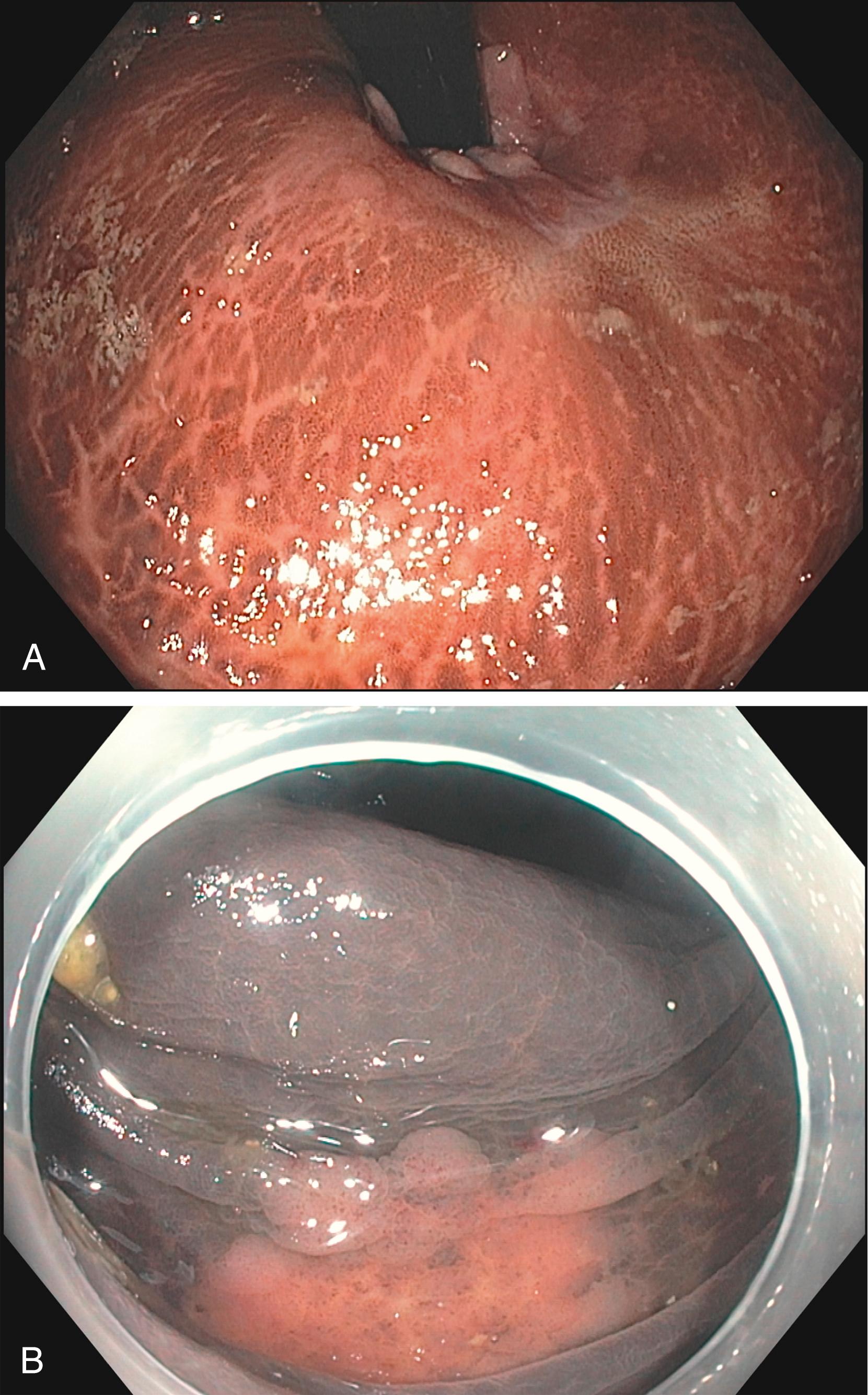
Concern about a possible relationship between melanosis coli and the development of colonic neoplasms has not been substantiated. , Of great interest and potential use to colonoscopists, however, is the fact that adenomas lack pigment-containing macrophages and thus are identified easily in patients with melanosis coli; this likely explains the increased adenoma detection rate in these patients (see Fig. 128.1 B ) , ; thus, biopsies should be taken of any non-pigmented area of the colon in a patient with melanosis coli. A recent case-control study showed a higher incidence of ileal ulcers in patients with melanosis coli, leading the authors to conclude that, perhaps, melanosis may be “a sign of chronic injury of colonic and intestinal mucosa”; there was no information on NSAID use in this study, however, apart from regular aspirin use being similar between cases and controls.
Chronic laxative users and abusers often complain of abdominal discomfort, bloating, fullness, or inability to defecate completely without using laxatives, but it seems more likely that these symptoms represent pre-existing constipation that led to chronic laxative use rather than any direct damage to the colon by the drugs. In severe cases of laxative abuse, electrolyte and fluid abnormalities are associated with excessive thirst and weakness.
Treatment of the symptoms of chronic laxative use is focused on correcting fluid and electrolyte imbalances, reducing or eliminating irritant laxative use, substituting bulking or osmotic agents, and assessing for pelvic floor dysfunction, an often overlooked cause of severe chronic constipation. Further details on the evaluation and management of chronic constipation can be found in Chapter 19 .
Damage to the colon has been reported after exposure to a number of rectally administered agents ( Box 128.1 ), including soaps and detergents used as “cleansing” enemas, hydrogen peroxide, water-soluble contrast agents such as sodium diatrizoate (Hypaque, Gastrografin), herbal medications, alcohol, and even hot coffee. Milder damage to the mucosa occurs after use of sodium phosphate enemas. The severity of the reaction depends on the type and concentration of the substance, the duration and extent of its contact with the mucosa, and, perhaps, the presence of underlying colonic disease.
Acetic acid
Alcohol
Ammonia
Caustic soda (sodium hydroxide)
Chloroxylenol (Dettol)
Ergotamine
Formalin
Glutaraldehyde
Herbal medicines
Hydrofluoric acid
Hydrogen peroxide
Lye
Potassium permanganate
Radiocontrast agents (Hypaque, Renografin-76)
Soap
Sulfuric acid
Vinegar
Soapsuds enemas were given decades ago to patients to “cleanse” their colons prior to colectomy. This practice has been largely abandoned because soaps produce liquefaction necrosis with mild to severe inflammation and saponification of the layers of the colon. Acute histologic changes include necrosis, leading, in more severe cases, to ulceration and possibly perforation. Acute colitis may heal without residua or with fibrosis and scarring. Endoscopic findings have ranged from loss of the normal mucosal vascular pattern to aphthae to mucosal sloughing and ulceration.
Colitis has been reported following the use of hyperosmolar water-soluble contrast materials that are often used to opacify the colon in cases of partial obstruction and to treat fecal impaction. Damage is believed to occur because of the hypertonicity of these agents, but the addition of agents to improve contrast may have contributed to mucosal damage because of their detergent properties. Most injuries have occurred in the colon proximal to an obstruction, suggesting that prolonged contact with these agents predisposes to mucosal injury.
Hydrogen peroxide enemas are no longer frequently used but, at one time, they were used to relieve meconium ileus and to remove fecal impactions. There are reports of profound damage associated with the use of hydrogen peroxide, including severe colitis, pneumatosis coli, perforation, sepsis, and death. Within minutes of contact, diffuse mucosal emphysema occurs, and after approximately an hour, the colon may become ischemic and eventually ulcerate; the so-called “Snow White” sign refers to the whiteness of the injured mucosa immediately after contact with the hydrogen peroxide and is characteristic ( Fig. 128.2 ). Acute colitis also has been reported after using glutaraldehyde to disinfect a colonoscope and then not sufficiently washing the agent off the instrument prior to its reuse ( Fig. 128.3 ).
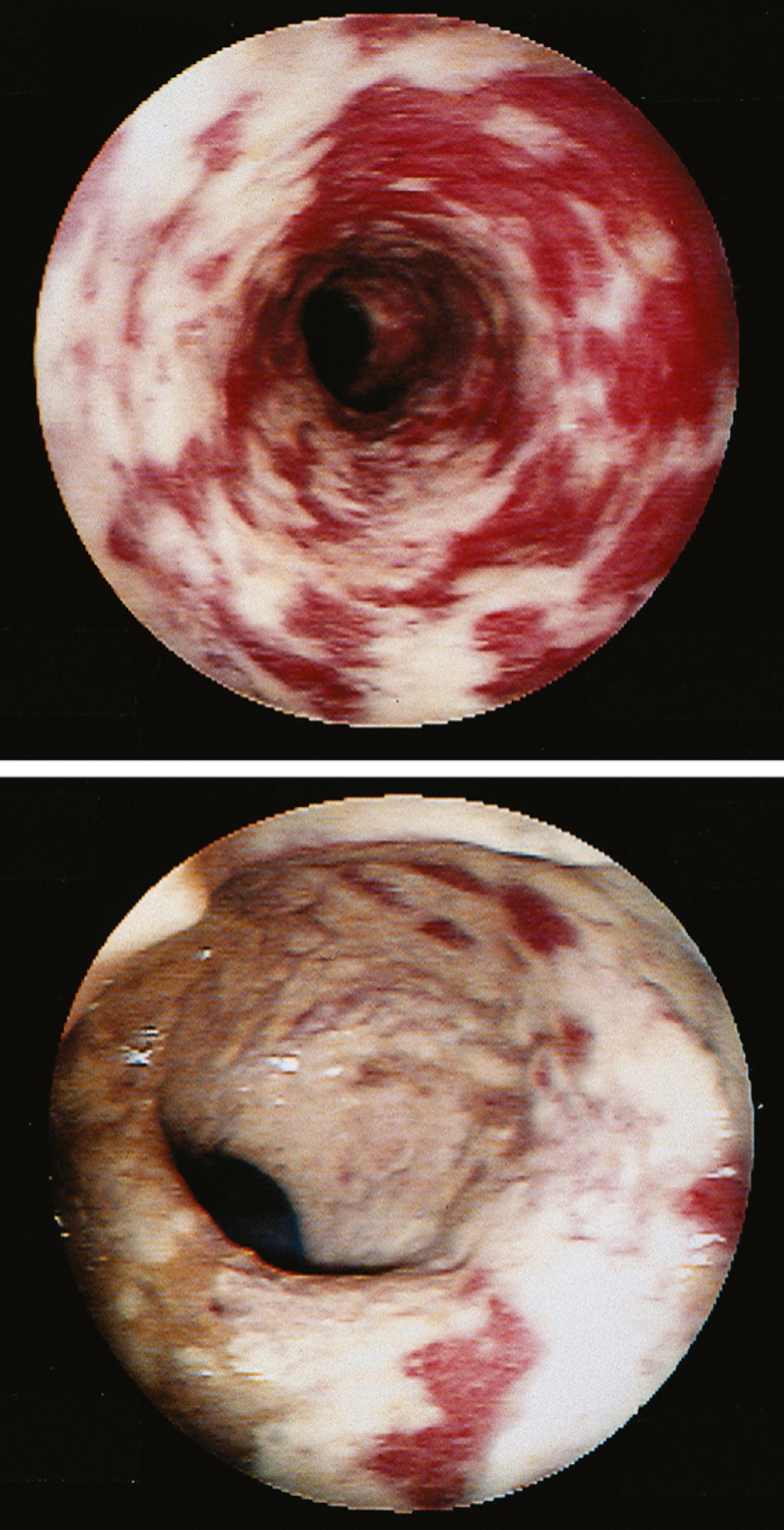
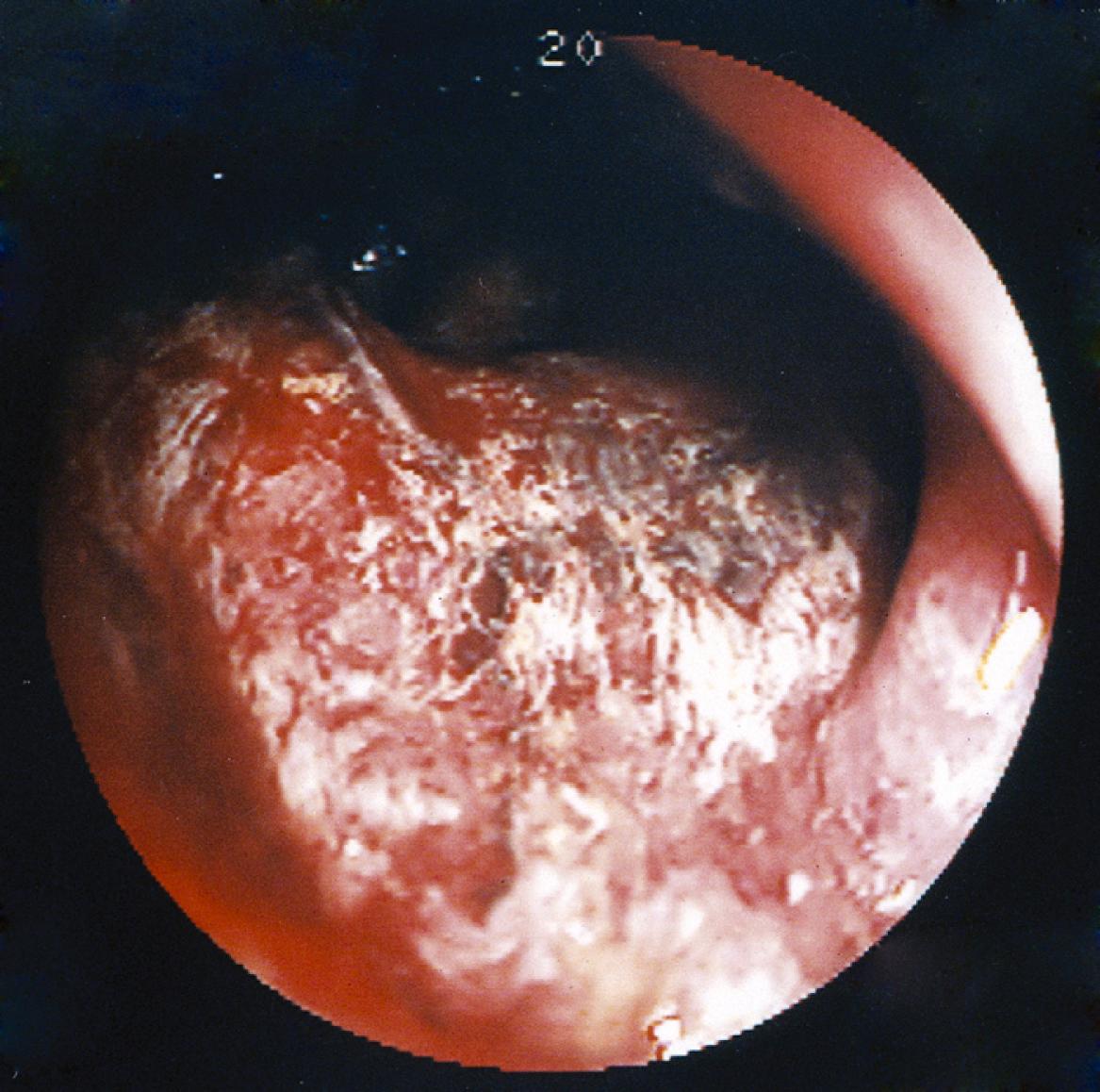
Soapsuds enemas and rectal instillation of substances for medicinal, social, or ritualistic activities, other than commercially available enemas, should be discouraged. Treatment of chemical colitis is largely supportive, with IV fluids and broad-spectrum antibiotics. Surgery may be indicated in severe cases of bowel necrosis or perforation. Most patients with milder injury will recover completely 4 to 6 weeks after injury.
Colitis cystica profunda (CCP) is a rare disease characterized by mucin-filled cysts located in the submucosa of the colon ( Figs. 128.4 and 128.5 ). CCP manifests in 3 patterns: (1) localized, with a polypoid lesion; (2) diffuse, with multiple polypoid lesions; and (3) diffuse, with a confluent sheet of cysts. In contrast, colitis cystica superficialis is an even rarer disease characterized by mucus-containing cysts that involve only the mucosa of the colon. It classically was described in association with pellagra, but also has been described in patients with advanced celiac disease, as well as thyrotoxicosis, uremia and mercury poisoning. Because of its rarity, it will not be discussed further.
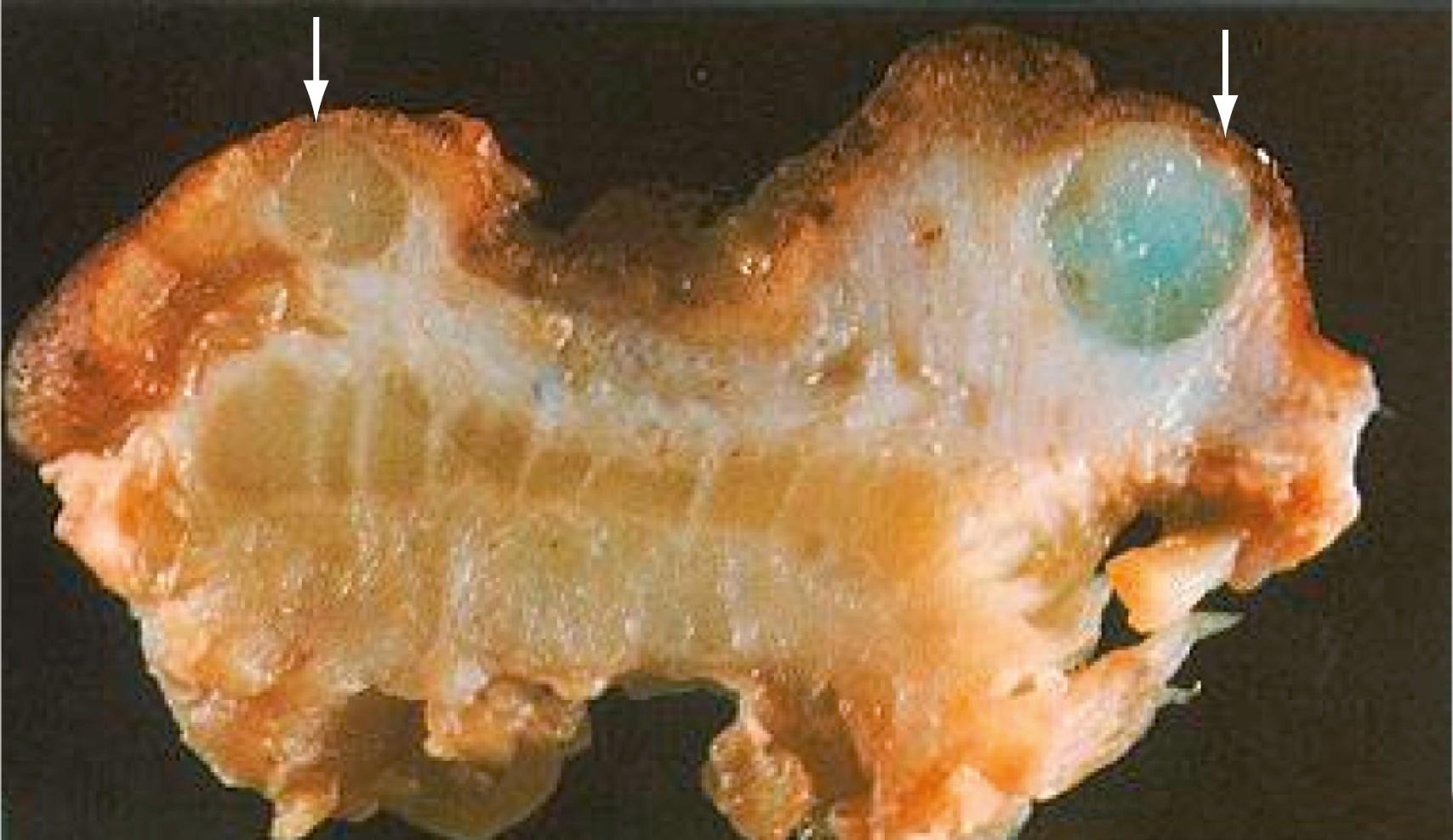
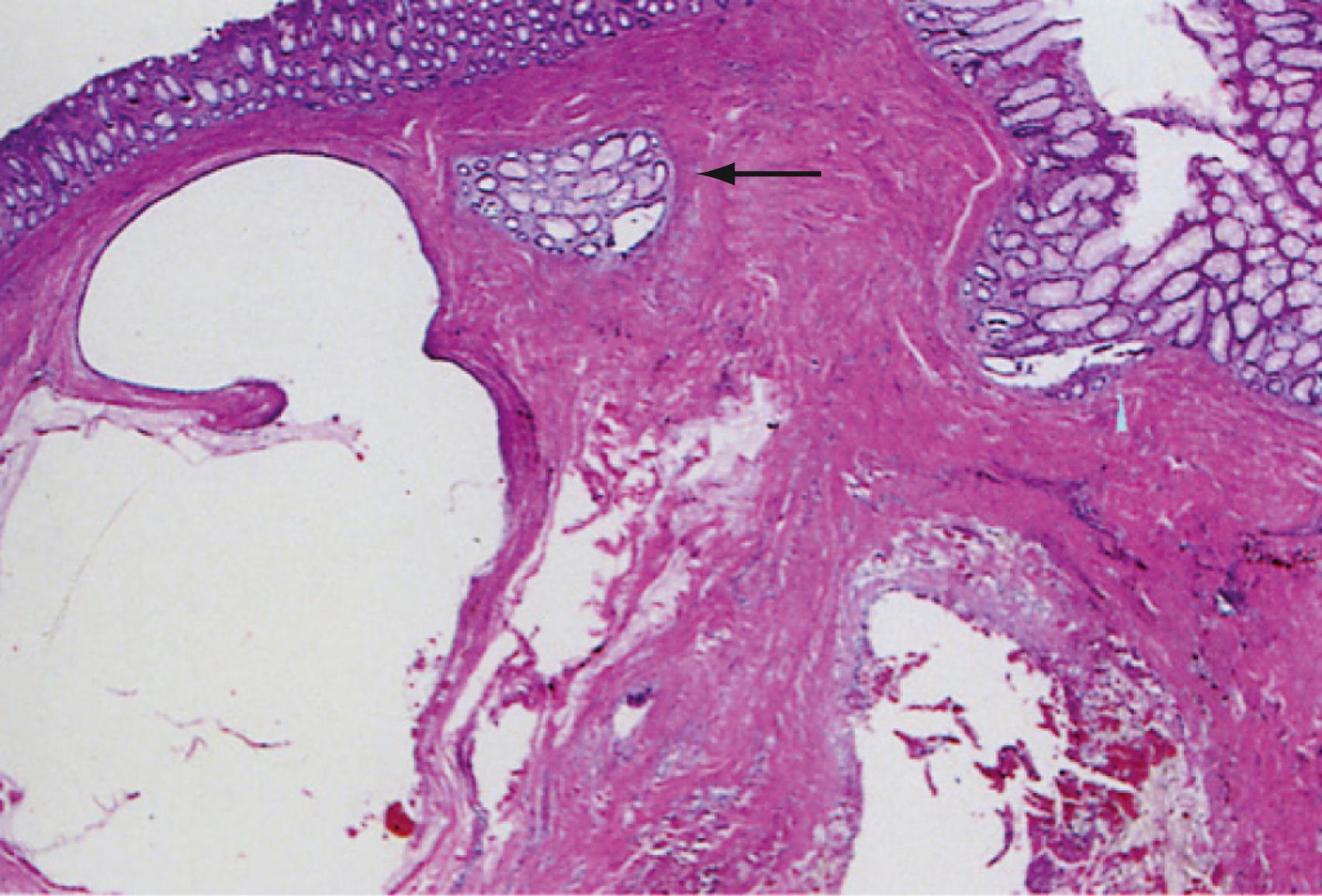
The etiology of CCP is unknown, but several theories have been proposed. A possible congenital etiology is supported by several findings. In embryologic examinations, submucosal cysts have been found in multiple GI locations. The occurrence of CCP in children and its association with other congenital conditions such as Peutz-Jeghers syndrome also support a congenital origin for this disease. Absence of submucosal cysts in large autopsy series of infants and children, however, reduces the plausibility of this etiology.
CCP has been associated with several acquired diseases that predispose to mucosal ulceration and inflammation, including UC, Crohn disease, and diverticulitis. Submucosal cysts have been reported in areas exposed to local trauma, especially surgical, for example, with intestinal anastomosis or colostomy. Proctitis cystica profunda also developed in rats treated with irradiation. CCP has been found in association with adenocarcinoma of the colon, and several cases of adenocarcinoma of the stomach have been reported with gastritis cystica profunda, suggesting a relationship with neoplasia. In some reports, there was strong evidence of a causal link between cancer and CCP, because the submucosal cysts were found adjacent to the adenocarcinoma, whereas adjacent benign mucosa was devoid of submucosal cysts.
The localized form of CCP is associated with rectal prolapse and solitary rectal ulcer syndrome (SRUS; see later). Mucosal prolapse has been found in more than 50% of patients with the localized form of the disease, and it is thought that trauma or ischemia caused by chronic traction on the mucosa and intramural vessels may play a role in development of the submucosal cysts. Microscopic features of the localized form of the disease often include fibrosis of the lamina propria and hypertrophic muscle fibers, changes that also are characteristic of SRUS.
CCP affects men and women equally. The most common symptoms are rectal bleeding, mucus discharge, and diarrhea ; less common are tenesmus, abdominal pain, and rectal pain. Rarely, the affected patient may present with intestinal obstruction caused by the cysts. At endoscopy, most (SRUS) lesions are located on the anterior rectal wall 6 to 7 cm from the anal verge. The lesions appear as polyps with overlying mucosa that may be normal, inflamed, or ulcerated, and may be indistinguishable from a variety of other lesions, including adenocarcinomas, adenomatous polyps, submucosal lipomas, neurofibromas, inflammatory pseudopolyps, pneumatosis coli, and endometriosis. Examination may disclose an associated rectal prolapse in some cases. Barium enema may reveal radiolucent filling defects. Rectal EUS may be useful in differentiating this disease from cancer and reveals hypoechoic cysts that are surrounded by intact submucosa, unlike invasive cancer. Biopsy is necessary to distinguish this lesion from the variety of inflammatory, neoplastic, and infectious conditions it may resaemble. On biopsy, the submucosa is thickened by the mucus-filled cysts (see Fig. 128.5 ), which usually communicate with the lumen through small openings in the mucosa. Although usually confined to the submucosa, cysts can involve the muscularis propria and serosa. Glandular epithelium is typically displaced into the submucosa (see Fig. 128.5 ), and care must be taken not to confuse these displaced glands with invasive carcinoma. The surrounding connective tissue often shows chronic inflammation, and there may be extensive replacement of the lamina propria by fibroblasts.
A high-fiber diet and bowel retraining to avoid straining have led to regression of this disease in a few cases. If fiber is not effective, polyethylene glycol solutions and glucocorticoid enemas have been used. Most symptomatic patients have been treated with surgery. In patients who have associated rectal prolapse, repair of the prolapse alone may treat the CCP, whereas in the absence of prolapse, excision through a transanal approach is efficacious. When the disease is localized to the rectum but is circumferential, total excision may be accomplished by mucosal sleeve resection and coloanal pull-through. More diffuse lesions have been removed by segmental resection, (see Fig. 128.4 ) which also may be necessary for large obstructing lesions and for lesions that cause hypokalemia, hypoalbuminemia, and severe anemia from chronic blood loss. A diverting colostomy may lead to regression of this disease and may be the best option for a patient with significant comorbidities.
Massive GI bleeding from an enlarged (“persistent caliber”) submucosal artery by way of a minute mucosal break typifies this ulcer, called a Dieulafoy lesion. Although occurring most commonly in the gastric fundus, identical lesions have been described throughout the GI tract including the colon and rectum. In the colon, Dieulafoy-type lesions appear to have a strong male predominance and have been reported in all age groups.
Histologically, the submucosal artery is tortuous and hypertrophic, curving toward the mucosa with persistence of caliber. Inflammation is absent, and the solitary mucosal break extends no deeper than the upper submucosal layer.
The clinical picture is one of acute, massive and, sometimes, recurrent bleeding. Colonoscopy can identify the lesion in some cases but is difficult or impossible when bleeding is ongoing. In such cases, selective mesenteric angiography is the diagnostic study of choice and therapy is with endovascular coil embolization, followed by surgery for failed hemostasis or perforation. In cases identified at colonoscopy, treatment with sclerotherapy, electrocautery, or hemoclipping may obviate the need for surgery.
Benign non-specific ulcers of the colon are uncommon, although their causes remain unknown. A large review of the literature encompassed 127 patients and indicated that colonic ulcers occur at any age, with a peak incidence in the fourth and fifth decades and a slight female predominance. Most such ulcers occur in the proximal colon, virtually all are solitary and located on the anti-mesenteric side of the colon, and most are round and sharply demarcated from relatively normal surrounding mucosa ( Fig. 128.6 ). Histologically, there is non-specific acute and chronic inflammation.
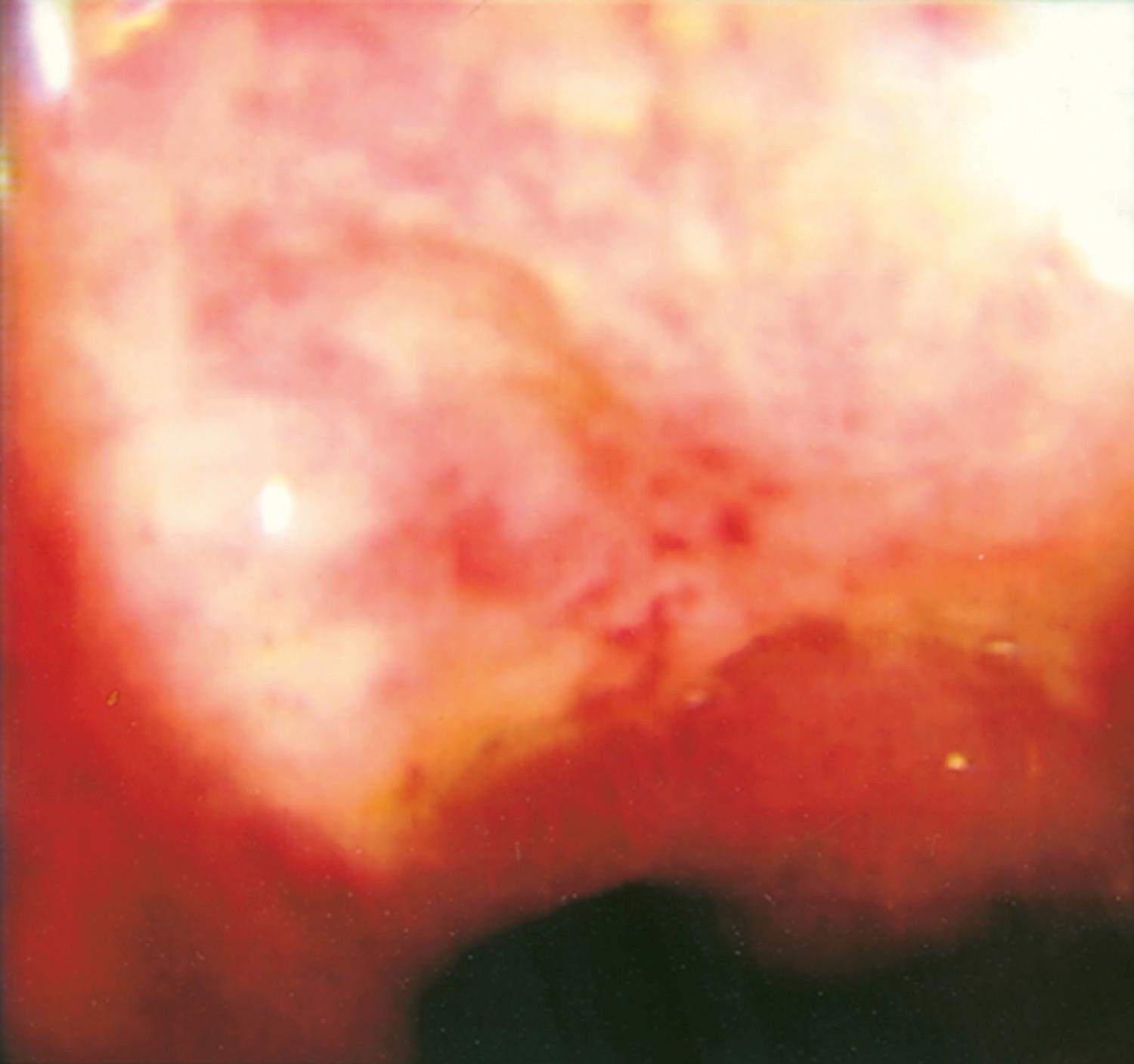
The causes of non-specific colonic ulcers are unknown. Hypotheses that have been advanced, but with little or no supporting evidence, include ischemia and cecal diverticulosis. Correlations with the use of drugs such as glucocorticoids, NSAIDs, , and oral contraceptives have been suggested, but these drugs have not been implicated in most of the reported cases. Additionally, there have been reports of associations of non-specific colon ulcers with chronic kidney disease and renal transplantation, eosinophilic granulomatosis with polyangiitis (also known as Churg-Strauss syndrome a), granulomatosis with polyangiitis (i.e., Wegener disease), Behçet disease, essential mixed cryoglobulinemia, and SLE. It is possible that a mechanism common to all exists, but none has been identified. Some of these cases may evolve into more typical-appearing Crohn disease.
The most frequent presenting symptoms are abdominal pain and bleeding. More than one half of patients with non-specific colon ulcers present with abdominal pain, often in the RLQ and mimicking appendicitis. One third have LGI bleeding with hematochezia, and 16% present with an abdominal mass, most often when the ulcer is located in the left or sigmoid colon.
Colonoscopy is typically how these ulcers are identified. Flexible sigmoidoscopy is inadequate because most colonic ulcers are proximal to the splenic flexure. Radiologic findings are non-specific and diagnostically inferior to colonoscopy. CT scans are most helpful to exclude perforation or abscess formation. The key to the diagnosis is exclusion of diseases associated with ulceration, including Crohn disease, infections (e.g., TB, Entamoeba histolytica , CMV, histoplasmosis, Salmonella typhi ), stercoral ulcers (typically in the rectum), and SRUS. Amyloidosis and neoplastic causes (e.g., carcinoma, lymphoma) are distinguished histologically.
In uncomplicated cases, an expectant approach is recommended, with interval colonoscopy to monitor healing. Surgery is recommended for complications such as perforation or significant bleeding, and for persistent symptoms.
SRUS is an uncommon disorder of defecation that affects patients of all ages and that became more widely recognized after a published case series by Madigan and Morson in 1969. The term is a misnomer: patients can present with hyperemic mucosa only, a solitary ulcer, multiple ulcers, or even a polypoid lesion resembling carcinoma that may be proximal to the rectum. Regardless of appearance, however, the histology of SRUS is characteristic, showing fibromuscular obliteration of the lamina propria and smooth muscle fibers that extend from a hypertrophied muscularis mucosa up toward the lumen. The diagnosis of SRUS often is delayed because of its varied endoscopic appearance and a lack of awareness of the disorder.
SRUS usually is considered to result from a disorder of defecation, but its pathogenesis is uncertain. A large subgroup of patients with SRUS strain excessively during defecation, and some have a behavioral disorder. Occult or overt rectal prolapse appears to be involved in many patients, with increased incidence of fecal evacuation disorder as evidenced by abnormal balloon expulsion testing and sphincter relaxation. It has been suggested that the rectal mucosa can be traumatized from being prolapsed through the anal canal and additional trauma may result from attempts to reduce the prolapse digitally. Alternatively, straining during defecation results in high fecal pressures that reduce local blood flow, causing ischemia and ulceration. The mucosa of the anterior rectal wall 7 to 10 cm above the anal verge is the most common area of such prolapse into the anal canal, and this corresponds to the usual location of ulceration in SRUS. The association of SRUS and rectal prolapse, however, is not universal, and the prevalence of associated rectal prolapse varies from 13% to 94%. SRUS also has been associated with the use of ergotamine suppositories and radiotherapy, further supporting a pathogenic role for ischemia. , Successful treatment of SRUS using biofeedback has been associated with an increase in local blood flow.
Diagnosis of SRUS is based on clinical symptoms, physical examination, endoscopic findings, and histology. Most patients with SRUS complain of passage of mucus and blood with defecation. Some also complain of tenesmus, straining, altered bowel habits, or a sensation of incomplete evacuation. Although men and women are affected equally, the usual onset is a decade earlier in men. The duration of symptoms prior to diagnosis ranges from 3 months to 30 years.
On digital rectal examination, there may be reduced anal sphincter tone and an indurated area or thickened folds may be palpated. Overt rectal prolapse may be demonstrated by having the patient strain as if to have a bowel movement. Sigmoidoscopy may demonstrate single ( Fig. 128.7 A ) or multiple ulcers or a patch of erythematous mucosa on the anterior rectal wall, usually within 10 cm of the anal verge. The lesion has a polypoid appearance in 25% to 44% of patients. Differential diagnosis includes IBD, malignancy, ischemic colitis, stercoral ulcer, medication-induced ulceration, trauma, and infections, including CMV, histoplasmosis, TB, amebiasis and secondary syphilis.
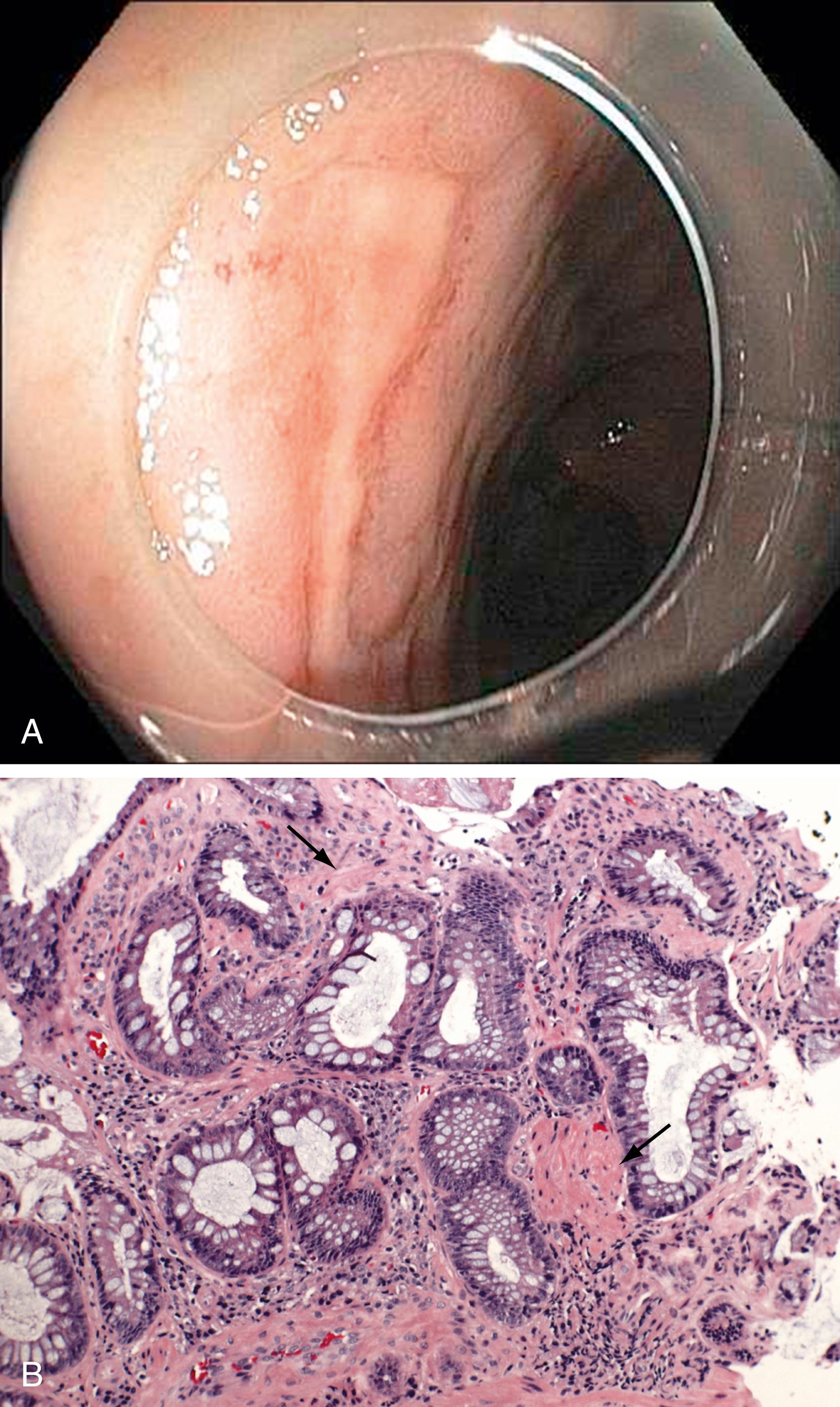
Biopsies should be taken from the ulcer margin and any other abnormal-appearing mucosa. In 1969, Madigan and Morson were the first to describe the histologic features of SRUS. There is fibromuscular obliteration of the lamina propria by collagen from fibroblasts and smooth muscle fibers derived from the muscularis mucosae. The muscularis mucosae is often hypertrophied, and its fibers are in continuity with those in the lamina propria. There is no significant inflammation. The polypoid variant is similar to the ulcerative variant except for regenerative hyperplastic changes such as cystic dilation and mucus production. Epithelial elements and lamina propria can be displaced into the submucosa (see Fig. 128.7 B ). This displaced tissue can then undergo cystic dilatation because of mucus retention. The misplaced and dysplastic-appearing glands may be misdiagnosed as adenocarcinoma, especially when the histologic and macroscopic features of SRUS are not recognized; at times, SRUS is present in association with a carcinoma, further confusing the issue.
Although not required in most patients, defecography may be useful to shed light on the pathophysiology of SRUS, especially if surgery is being considered. Defecography is used to demonstrate mucosal prolapse, intussusception, rectal prolapse, a non-relaxing puborectalis muscle, and incomplete or delayed evacuation. Endorectal US may be useful to distinguish SRUS from other conditions such as invasive cancer.
Become a Clinical Tree membership for Full access and enjoy Unlimited articles
If you are a member. Log in here